Shipping Policies: How to Create a Bulletproof Shipment Policy With Optimized Logistics
10 min read

When doing business as an online retailer, you don’t have the luxury of building a personal relationship with your potential customers. They might never have seen your logo before or stepped foot in one of your retail stores (if they exist).
So how can you earn their trust to drive them to buy?
When done right, a shipping policy can not only help you alleviate the doubts of your prospective customers but become a competitive advantage that drives higher conversions and improves your customer’s lifetime value.
In this article, we dive into what a shipping policy is, the most critical areas to cover, show you three examples from ecommerce giants, and provide you with a sample shipping policy template.
What we’ll cover (click below to navigate this comprehensive guide):
- What Is a Shipping Policy?
- 8 Essential Parts of Your Shipping Policy
- Where to Showcase Your Shipping Policy
- 3 Real-World Shipping Policy Examples
- How Do I Create a Shipping Template in Shopify?
- Shipping Policy Templates
- How Optimized Shipping Can Boost Your Sales & Revenue
- How to Enforce an Ambitious Policy
- How OptimoRoute Can Transform Your Shipping Process (with case studies)
- Final Thoughts
What Is a Shipping Policy?
A shipping policy is a document or page that highlights your rules, commitments, and procedures for shipped items. These policies often include rules for returning lost goods, exchange policies, responsible parties for pricing, and delivery timelines.
Unlike a privacy policy, you are not legally obligated to include a shipment policy on your ecommerce site, but it’s highly recommended to assuage any potential customer doubts and ensure a smooth ecommerce shipping process.
8 Essential Parts of Your Shipping Policy
Every part of your shipping policy should answer a vital question from a potential customer.
In this section we’ll cover the essential parts of a shipping policy you should be sure you’re covering.
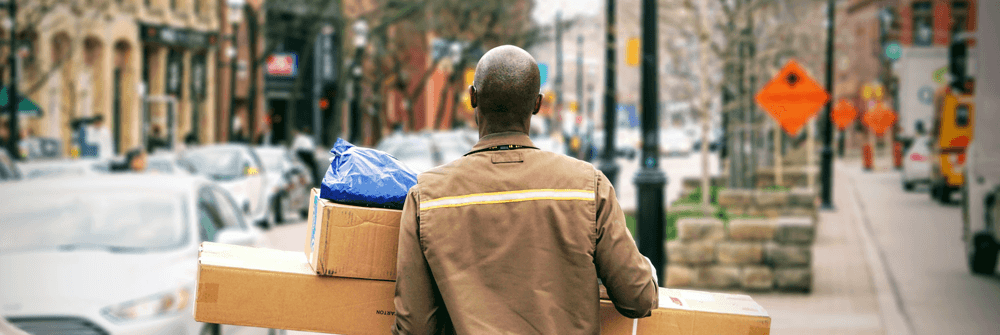
#1. Shipping Options
In this section, you want to cover the different mail carriers your customers can choose from (e.g. USPS, UPS, Fed-Ex).
Most modern ecommerce platforms like Shopify and BigCommerce will automatically include this information as part of your checkout process.
Questions to answer:
- What are the shipping options?
- Do you offer express options?
- Can I choose my favorite or most trusted carrier?
#2. Shipping Costs
Here, you’ll want to cover shipping costs in as much detail as necessary.
Unless you offer free shipping, it’s not enough to hide this information away on a policy page — you must also include the shipping costs right on the checkout page, and any receipts or invoices.
Question to answer:
- What does it cost to get the package delivered with each carrier and option? How much does it cost to track a package as well?
#3. Delivery times
Delivery timeframes are a priority for the modern consumer, so make sure you cover estimated delivery times to different states and countries.
Question to answer:
- How long will it usually take for your products to reach a customer? (Including processing time.)
#4. Lost or damaged products
Detail your policy on lost or damaged products in detail. Include whether you replace them, offer a full refund, cover the return shipping costs of damaged goods, and more. To learn more, check out our post on delivery exceptions.
Question to answer:
- What happens when a product is lost or damaged in transit?
#5. Returns & exchanges
Cover your return, exchange, and refund policy, including shipping costs, time restrictions, and more.
Questions to answer:
- How and when can a customer make a return?
- Are exchanges possible through your store?
#6. International shipping
If you ship internationally, you need to cover the costs, estimated shipping times, and more for all relevant countries or regions.
Questions to answer:
- Do you ship to other countries?
- Are there additional shipping costs?
- How long does it take to ship to a customer’s country or region?
#7. Taxes and import fees
If you handle international orders, you also need to cover foreign sales tax and import fees, and whether you handle them and calculate them into product prices on your site.
Questions to answer:
- Who will pay these shipping charges on arrival?
- Are they calculated and included in the product prices in your store?
#8. U.S. Territories
If you ship beyond the continental United States, you should include any potential extra costs or additional shipping or processing time.
Questions to answer:
- Do you deliver to Puerto Rico and other U.S. territories?
- Do you ship to APO, FPO, or DPO addresses?
Where to Showcase Your Shipping Policy
If you’ve already covered your bases (and all the sections above), with your policy, your potential customers have all the information they need.
But it doesn’t matter how great your policy is compared to your competitor’s if your customer never sees it.
So where should you showcase your shipping details and return policy? Should you leave it on a dedicated policy page with a link hidden at the bottom of your website’s footer?
Below, we cover the ideal locations to highlight your policy.
FAQ pages
One of the best ways to highlight your shipping policy is to split it up into logical questions and include it in your help center or FAQ section.
Here’s a great example from LittlePosy.com – a flower delivery company in Perth, Australia:
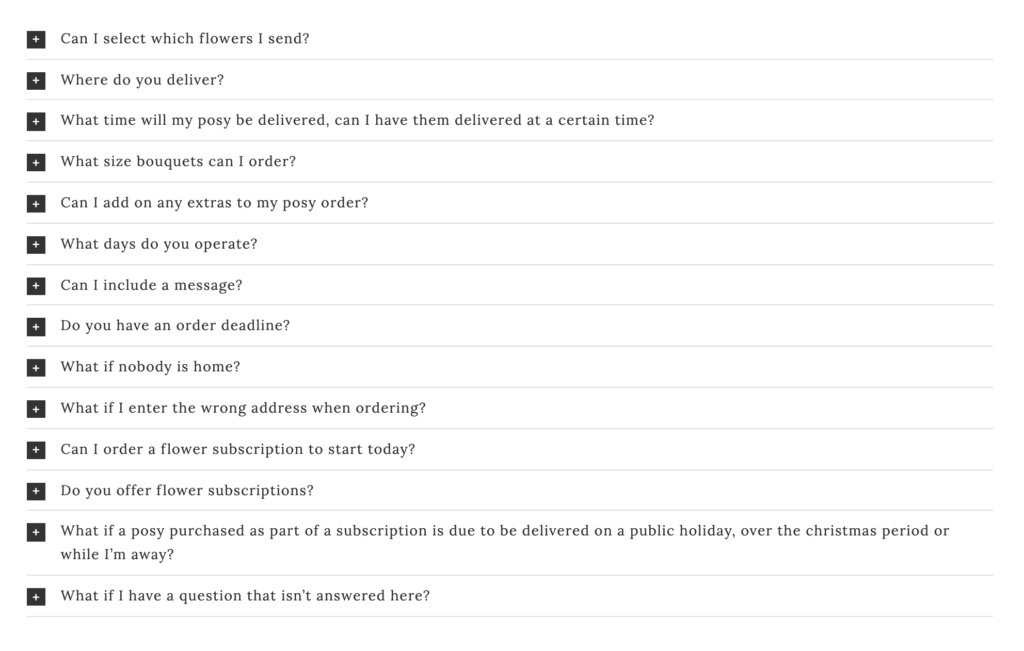
Product pages
You should also highlight the most important details from your policy on product pages so your customers know what to expect.
Checkout process
Finally, you should confirm the essential details (like shipping price, expected delivery time, and more), during the checkout process and in the confirmation email.
Footer link
Because consumers expect policy links in the footer, it’s a good idea to cover your bases and include a link to your shipping policy alongside your privacy policy or terms and conditions.
3 Great Shipping Policy Examples
In this section, we’ll cover and compare three different examples of shipping policies from ecommerce giants.
We will analyze what content they choose to highlight, what they do right and wrong, and what you could learn and apply in your own policy.
Example 1: Warby Parker’s shipping policy
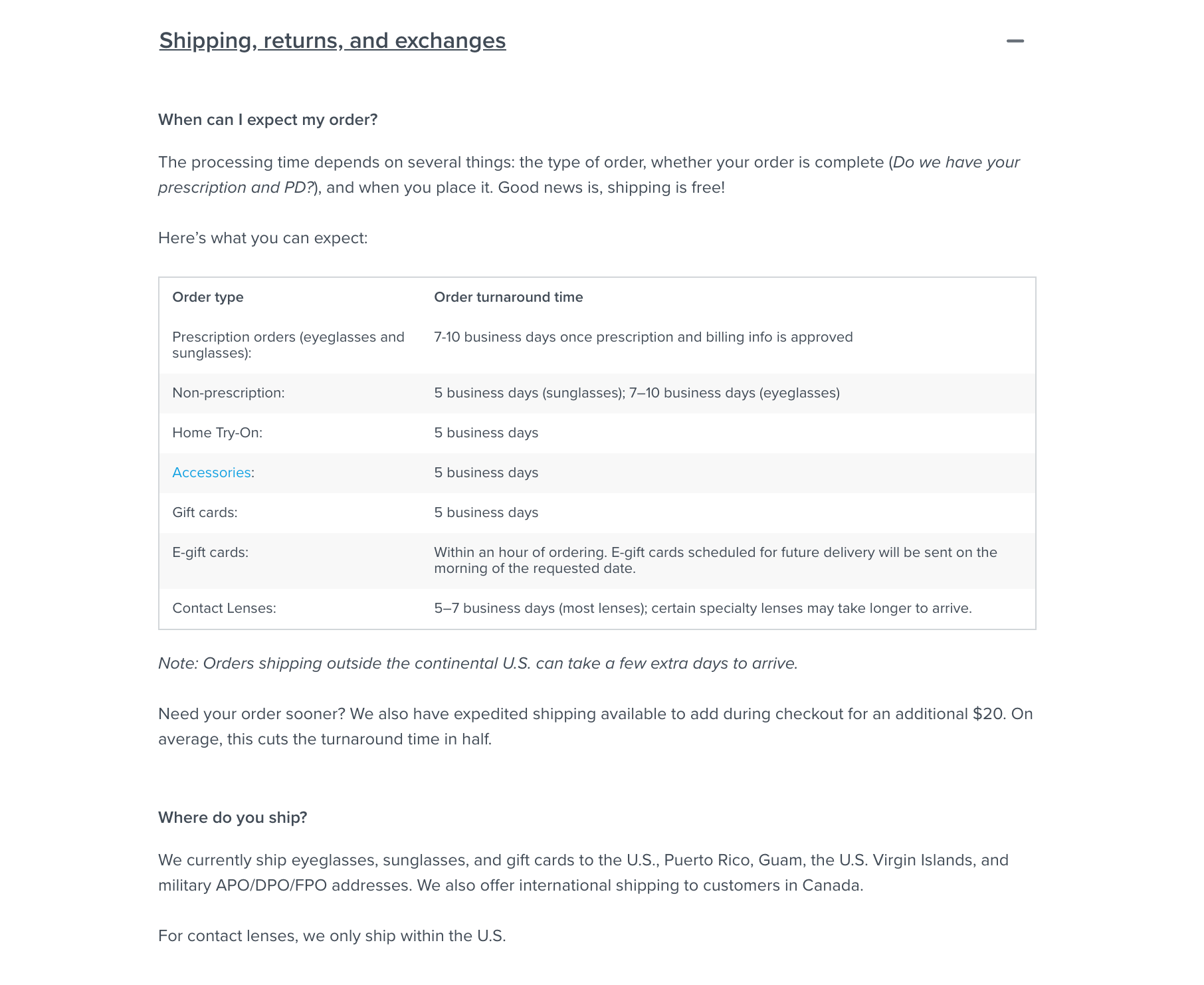
Warby Parker lays out the expected turnaround time for a variety of products, including processing and handling time. The policy clearly states the number of business days a customer should expect to wait before receiving a product.
Since the required order processing time is different, being upfront about this in the policy will help minimize unnecessary support requests about “late” or “delayed” orders.
Warby Parker markets itself as a more convenient alternative to visiting an optometrist or brick-and-mortar store. That’s why their free shipping and returns policy is plastered front and center not just on their dedicated policy page, but on their homepage, product pages, and shopping carts.
If you are dedicated to offering a better customer experience, you can highlight similar benefits, like free shipping, fast delivery, or real-time order tracking on important pages.
Example 2: Home Depot’s shipping policy
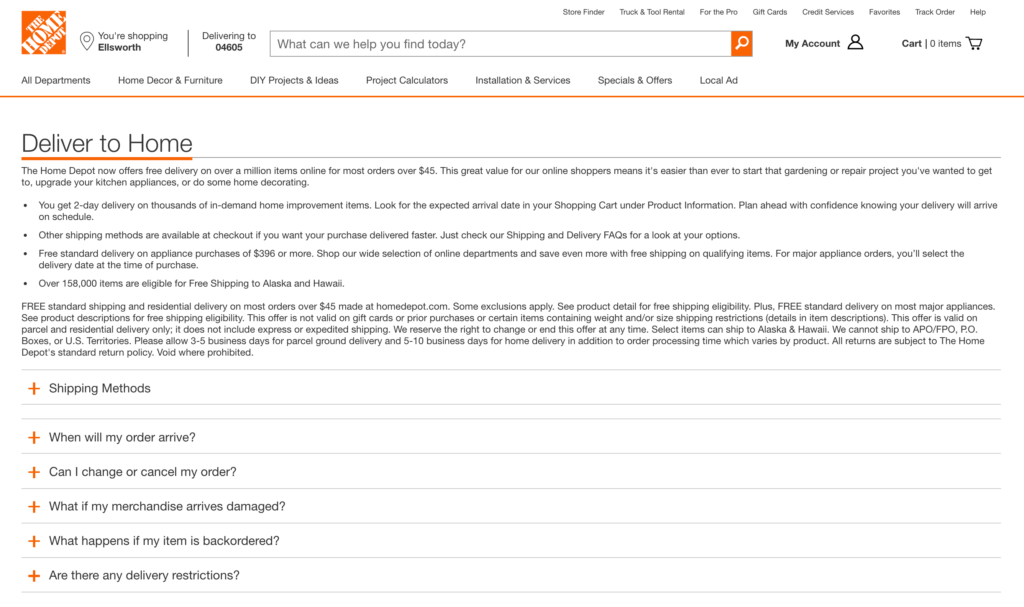
Home Depot offers the policy in an expandable FAQ format that is easy for prospects and customers to understand.
The page highlights essential information, like the terms for free shipping, whether shipping is available to Hawaii and Alaska, and more.
The rest of the info is separated into expandable sections with simple, question-based headlines. This approach makes it easy for customers to browse and find the information they are looking for.
Example 3: Best Buy’s shipping policy
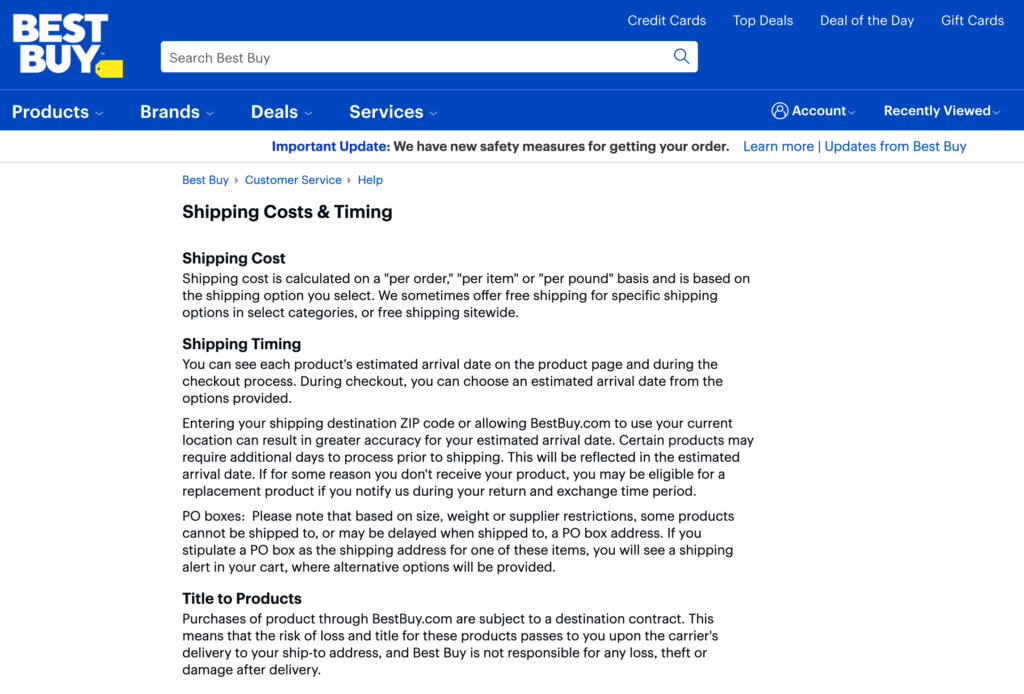
The difference with Best Buy’s policy is that it doesn’t cover the individual shipping costs and delivery time expectancies on the policy page at all.
It covers those details on the checkout page, which makes it less confusing for customers, as they won’t have to search for the relevant prices and transit times in a table.
If you highlight important information in other locations that are more visible to customers, you can use a policy page to direct customers to the relevant information, as Best Buy does here.
How Do I Create a Shipping Policy on Shopify?
If you use Shopify, you shouldn’t be manually adding your policy into template files, but rather using their built-in shipping policy feature.
If you haven’t added a policy yet, you should see a section like this on the homepage of your Shopify dashboard. Click the “Add shipping policy” link and proceed. (If you can’t find it, go to Settings > Legal and scroll down to the “Shipping policy” section).
From here, you can freely add content using a rich text editor. If you have a policy in a Google or Word doc, you can just copy, paste, and save it.
It really is that simple.
Shipping Policy Templates
You can easily create your own custom shipping policy by editing and filling out an existing template.
We’ve scoured the web for the best templates, and included direct links to the templates in Google Docs.
- Termsfeed’s shipping policy template.
- Shipbob’s shipping policy template.
How Optimized Shipping Can Boost Your Sales and Revenue
Shipping and logistics don’t have to be a boring, monotonous part of your business.

With the right approach, you can turn your business’ shipping and delivery ability into a competitive advantage, land more sales, and improve customer loyalty.
Sell more products with free shipping or 2-day premium options
85% of online shoppers prefer free shipping over express options, and 68% expect their purchase to arrive within 3-7 days. 67% of shoppers who pay for shipping want their item in 2 days, ideally next-day or same-day delivery.
So if you want to grow your ecommerce business, you need to dedicate yourself to speeding up and ensuring the accuracy of your shipping.
Improve customer experience for higher LTV
Shipping and delivery is a key part of the customer experience when you sell physical products online. If you can process and ship products faster than your competitors, that can make the experience of shopping with you better, winning you the long-term loyalty of your customers.
Companies that focus on customer experience grow customer lifetime value 60% faster than their industry average.
How to Enforce an Ambitious Shipping Policy
A shipping policy can’t become an advantage if it doesn’t meet or exceed customer expectations. But the worst thing you can do is overpromise and underdeliver.
Having an ambitious shipping policy, and keeping to it, can be a challenge, but done right, it becomes an incredible business asset.
Here are a few strategies to ensure you can uphold your shipping policy’s promises.
#1. Optimize your logistics with software
If you promise a shipment will reach anywhere in the U.S. within a few days or a week, you better have optimized logistics and shipping to back that up.
To meet the expectations of customers, you need efficient warehouses, distribution centers strategically located throughout the U.S., and reliable partners.
OptimoRoute can help you efficiently manage your fleet of freight trucks and drivers. Our route optimization tools will automatically plan the most efficient routes for your delivery drivers, cut down on planning time, and more.
If you handle your own deliveries, features like custom delivery time-windows and real-time order tracking (with notifications) can help you minimize failed deliveries and maintain a good customer experience. This can have a dramatic impact on your logistics efficiency.
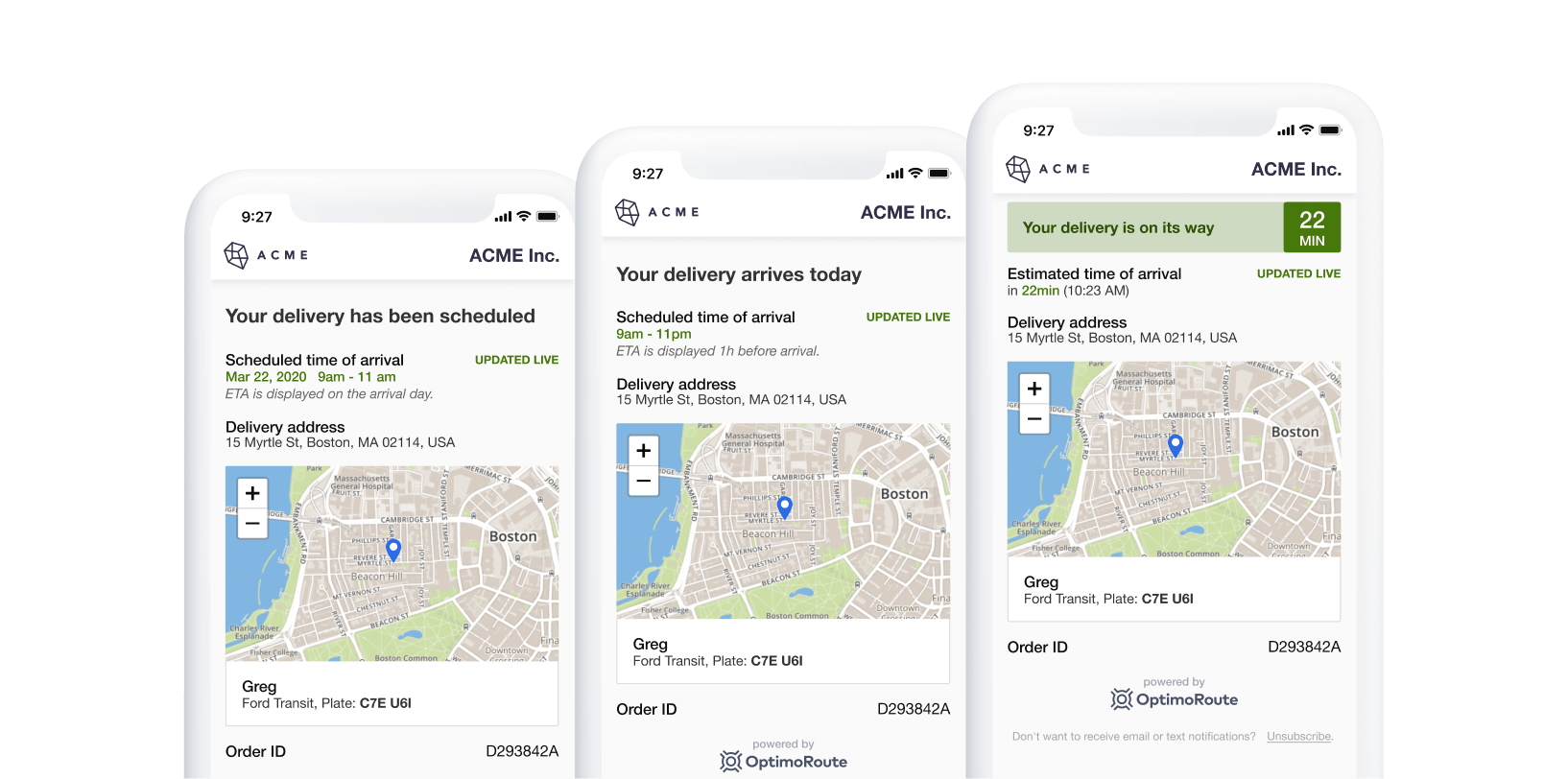
#2. Plan loads and routes that consider driver & vehicle constraints
Planning how to load and ship multiple small packages over long distances is a complex task.
You need to assign orders based on the required vehicle capabilities and driver qualifications, plan lunch breaks at the ideal times, and be completely aware of all cargo space in all vehicles. You must also plan and adjust restockings at the warehouse every day.
OptimoRoute makes this easy, and helps you automatically ensure that vehicles aren’t overfilled or overloaded when picking and shipping goods.
#3. Make sure customers read your policies
Show the policy at checkout or have your customers opt to read it before checking out. Many sites do this in a non-obstructive manner.
Studio Neat’s checkout process includes a shipping method section with basic pricing and delivery, with a link to their policy on returns and exchanges.
How OptimoRoute Can Transform Your Shipping Process
With the right route optimization tool, you can drastically speed up your shipping process, improve shipping accuracy, and minimize failed deliveries.
Don’t give some customers tariff refunds and others nothing, enforce the rules in your policy as steadfastly as possible. Make sure every staff member involved knows that maintaining the standard is a priority.
Here’s how OptimoRoute can help you enforce your shipping policy to give you a competitive edge.
#1. Automatic route planning & optimization
OptimoRoute will automatically plan the most efficient routes for your drivers and vehicles, considering vehicle capacity & capabilities, driver workloads, customer time windows, and more.
OptimoRoute’s route planning has helped our clients achieve a 20% decrease in mileage, while simultaneously planning 8 times faster and reducing manpower by 60% — because our software doesn’t rely on manual re-calculations.
#2. Mobile application for delivery drivers
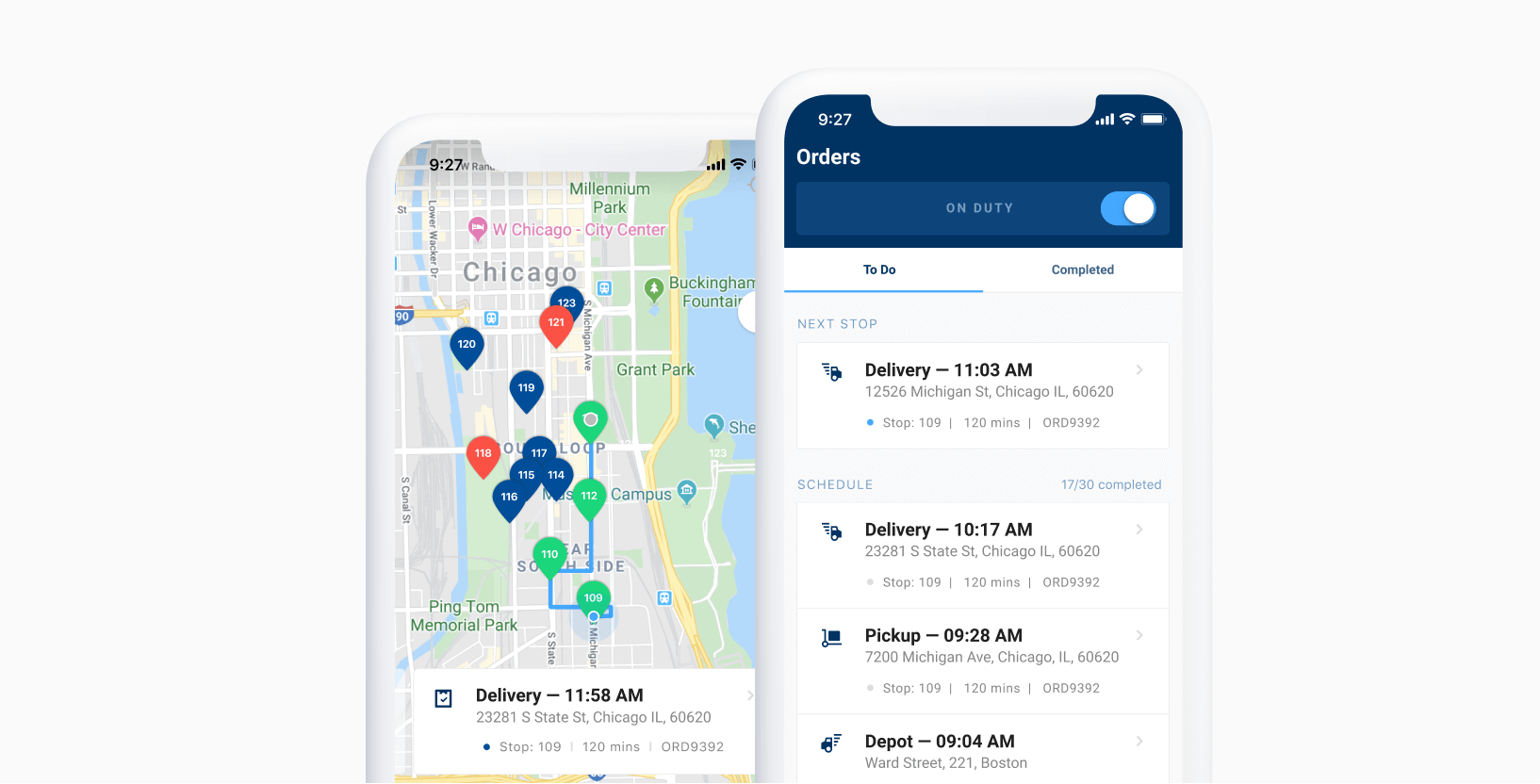
With OptimoRoute’s mobile app for drivers, it’s easy for them to follow directions and stay on schedule. Remove chances for human error, and schedule every delivery and location ahead of time with the fastest route possible.
#3. Live tracking and ETA
With live GPS-tracking of your vehicles, you can provide your customers with a precise ETA or time window. Allow them to plan their day ahead and spend less time re-arranging work or deliveries.
#4. Realtime Order Tracking
Let your customers see where the delivery driver is in real-time with a tracking number or link, instead of having to waste resources on incoming customer service calls about their delivery’s ETA.
#5. Email & SMS delivery notifications
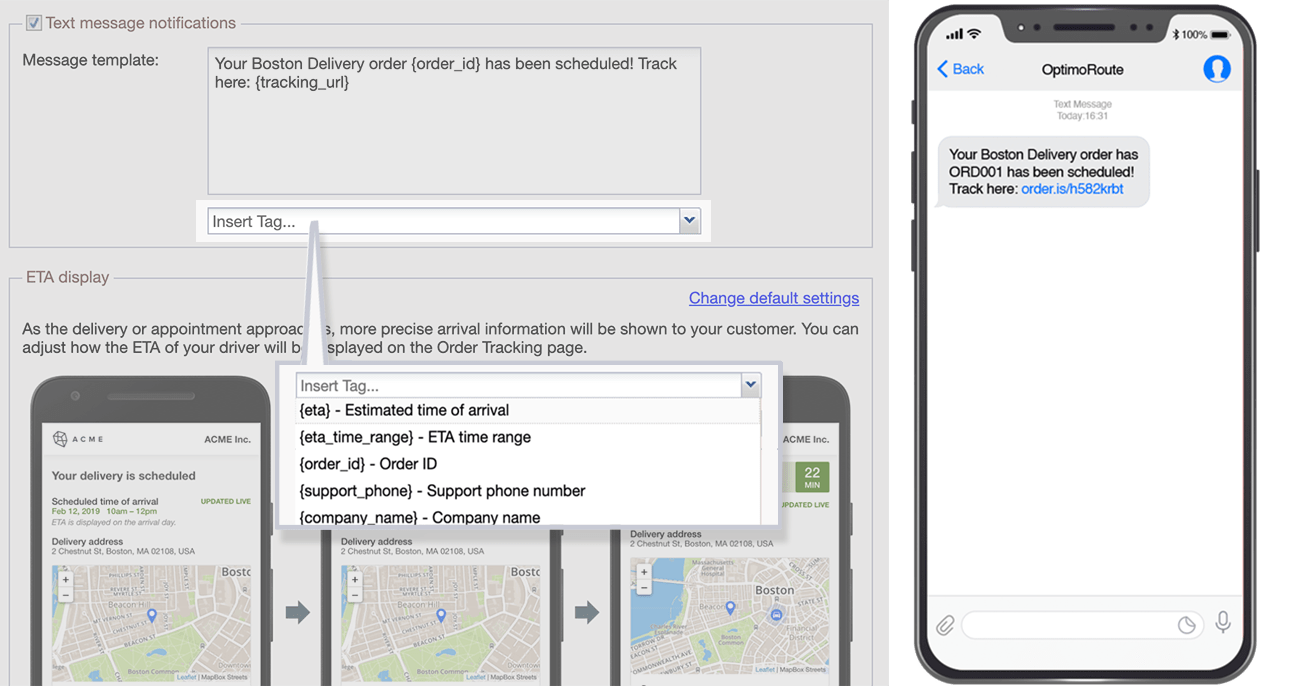
Improve your customer experience and minimize failed deliveries by automatically sending SMS and emails ahead of deliveries or service calls.
These features can completely transform your shipping operation, from warehouse loading to last mile delivery.
Real-World Case Studies:
#1. Hardie’s Fresh Foods:
With OptimoRoute, Hardie’s Fresh Foods has increased its delivery capacity by 14% and reduced driver costs by 12%. On-time delivery (OTD) rate improved from 89% to 94% and is still rising 1.5% MoM.

#2. The Little Posy Co:
OptimoRoute helps The Little Posy Co. (a flower delivery service in Australia) adapt to changing seasonal needs quickly and seamlessly.
This enables them to keep to their shipping policy even when, on Valentine’s Day, their deliveries increase by 500% and they triple the number of drivers needed from 20 to 60:

“OptimoRoute has changed the impossible to the absolutely possible on Valentine’s Day. It takes the pressure off – I could not fathom how the workflow could function so smoothly without this piece of software.”
“Having OptimoRoute makes this many orders possible. I couldn’t even imagine having to dispatch 1,000 orders without OptimoRoute because it’s literally a few clicks of a mouse and the routes are perfectly mapped.”
Final Thoughts
At first glance, a shipping policy might appear as just some boring legal document that won’t have any real impact on your business. That’s only the case if you’ve settled for logistics and shipping being mediocre.
If you are dedicated to delivering a better experience to your customers, that also includes how you handle shipping and delivery.
If you devote yourself to optimizing your logistics, outdoing your competitors, and exceeding customer expectations, you can turn a boring shipping policy into a competitive advantage that increases customer loyalty and lifetime customer value.
If you want to optimize the efficiency of your delivery fleet, try OptimoRoute for free, today.
Try OptimoRoute™ for Free
No installation or credit card required


